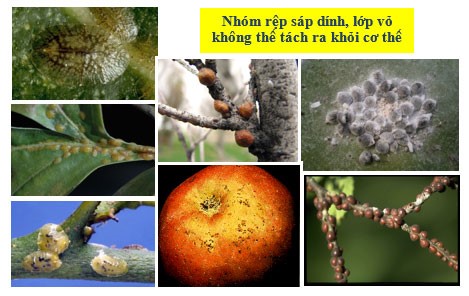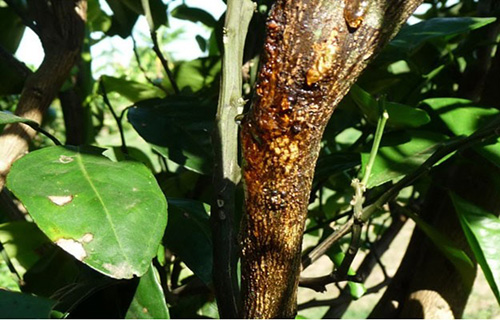|
GROUP OF MEALY BUG HARMFUL ON CITRUS
21/06/2023
GROUP OF MEALY BUG HARMFUL ON CITRUS TREES 23/05/2022 - Total family: Coccoidea - Order: Homoptera a. Harmful genuses : This group includes species that are generally very small in size, causing damage by sucking plant sap (on leaves, fruits, branches, stems). There are many species of mealybugs present on the group of Oranges,Tangerines,Grapefruits and Lemons (Citrus), which can be divided into 2 groups: + Group of sticky mealybugs with common varieties such as Lepidosaphes, Aonidiella, Coccus and Saissetia. + Group of flower mealybugs with common genera and species such as Pseudococcus, Planococcus and Icerya purchasi. b. Morphological characteristics:
The shell of the Sticky Mealybugs can detach from the body easily, as in Aonidiella, Lepidosaphes, or form a skin wall that cannot be separated from the body as in Coccus or Lecanium.
c. Biological characteristics: The development process of mealybugs is very complicated, female larvae are wingless. Sticky Mealybugs usually live permanently (except for 1- year- old one and male adult ) at one location to suck and mate and reproduce, so this group is also known as Sticky mealybug. In the group of white mealybugs, many species at the larval stage of 1, 2 and 3 years old and even adults can still move. Mealybugs all have short growth cycles (most of them are less than 1 month in the Mekong River Delta), high fertility, some species lay eggs and some give birth. rapid outburst. d. Harmful characteristics: Cause damage by sucking (larvae and female adult) leaves, branches, fruits, fruit stalks. If severely infected, leaves turn yellow, fall off, branches dry and die, fruit may also become discolored, develop poorly and fall off. Causes damage mainly in the dry season. Sweet nectar secreted by planthoppers also attracts sooty fungi to grow, affecting the photosynthesis of plants. In the Mekong RiverDelta, initially recorded over 16 species of mealybugs present on oranges, citrus, lemons. In general, although present quite commonly, the population of mealybugs is usually low, so no significant harm has been seen. It may be because in natural conditions, mealybugs have a lot of natural enemies (in which the most important ones are parasitic wasps such as Encarsia, Aphytis, Metaphycus and Ladybug species), these natural enemies have high ability to limit the outbreak of mealybugs. Conservation of natural enemies in nature is a prerequisite to prevent the outbreak of mealybugs in natural conditions. In many countries, people have raised, multiplied and released parasitic wasps to control mealybugs in citrus orchards. e. Preventive measures: Under natural conditions, this group has not seen significant harm. Only use thse product when the density is high (5-10% of the fruit is infected, about 5 adults/fruit or leaf) and when 5% of the trees in the garden are infected. Because the bodies of insects in this group are covered with wax, the use of chemical products for prevention is not simple and the incorrect use of chemical products can affect the natural enemies of the mealybugs in nature. Many survey results show that some chemical products are effective against Mealybugs when not continuously using a certain type: Secsaigon 25EC, 50EC, Sairifos 585EC, Fenbis 25EC, Sago-Super 20EC… It is recommended to use the above chemical product combination with SK EnSpray 99EC Mineral Oil, however, to avoid the effect of Mineral Oil on plants, the recommended concentration must be respected when mixing (0.25%). Note: Must be mixed with water first, then mixed with mineral oil . |
To prevent, in addition to plowing and burying weed seeds, collecting weed stalks and stumps left after tilling the land to burn, not letting weeds produce seeds in production fields, etc., the use of chemical products is still a measure. optimal because of its ability to thoroughly kill weeds, reduce labor and take advantage of more time than manual weeding.
Miner has the scientific name Phyllocnistis citrella Staint., family Phyllocnistidae, order Lepidoptera. The miner occurs in many countries in the tropics and subtropics. The main host of the miner is the citrus family - Rutaceae. In addition, the miner also attacks mangosteen and some other plants.
Adult is a small planthopper, with a body 2-3 mm long, the whole body is ash gray, slightly greenish, the wings are opaque with many small brown spots.Eggs are oval, 0.3 mm long, have a pointed end and are attached directly to the leaf surface, leaf axils.
Green bugs specialize in the fruit of citrus groups (oranges, tangerines, lemons, grapefruits, kumquats...), some people call them orange bugs, or orange suckers. Their scientific name is Rhynchocoris poseidon or Rhynchocoris humeralis.
In Vietnam, yellow leaf curl disease is very common on papaya trees, especially the disease is often severe in areas of high and continuous planting, areas with hot and arid climates. The disease has significantly reduced the yield and quality of papaya. Gardens that are infected early when the plants are young may not yield. However, up to now, many gardeners still do not know the cause and how to fix it.
Spider mites are common pests on citrus trees, especially in hot and dry climates that are suitable for spiders to grow and cause severe damage.The group of harmful spiders is usually very small in size, unlike the natural enemy spiders.
Dry branches and berries disease often appear to be common damage on coffee gardens during the rainy season. The disease causes death of branchs, dry fruit, severely affects the canopy structure and coffee yield if not paid attention to prevention.
Pink disease commonly causes diseases on rubber plantations in the rainy season, especially on garden from 4-8 years old. This year, rubber has to go through a period of severe drought, weakening the tree, so now in tnshe rainy season it is easy to get infected. Therefore, it is necessary to pay attention to good management to avoid affecting the garden.
In recent years, the area of citrus has been expanded because it is a fruit tree with high economic efficiency. However, in order to sell at a high price, not only in quality but consumers also require the external beauty of the fruit, so pest management on citrus is a matter of great concern to farmers. The hot season is a favorable condition for thrips to develop and cause damage, affecting the commercial value of fruit.
Currently in Vietnam, the cultivation of citrus trees is playing an important role in the country agricultural production. The benefits of citrus trees have made many farmers rich. However, wherever citrus trees are planted, fissured trunk cracking appears and causes damage. If any gardener is negligent or lacks attention to this disease, the tree will die, even the whole garden.
- Headquarters
- SAIGON PLANT PROTECTION JOINT STOCK COMPANY
- RQ 1, Nguyen Van Quy St., Tan Thuan Ward, HCM City
- Tax code: 0300632232
- Tel: (028) 38 733 295 - 38 732 077
- Fax: (028) 38 733 003 - 38 733 391
- Website: www.spchcmc.vn - Email: info@spchcmc.vn
- SAIGON PLANT PROTECTION COMPANY
- SAIGON PLANT PROTECTION JOINT STOCK ENTERPRISE
- Lot C1-C3 Hiep Phuoc Industrial Park, Hiep Phuoc Commune, HCM City
- Tel: (028) 3873 4089 - Fax: (028) 3873 4086
- Affiliated Unit
-
- Quick Links
- Home
- About us
- Career Opportunities














